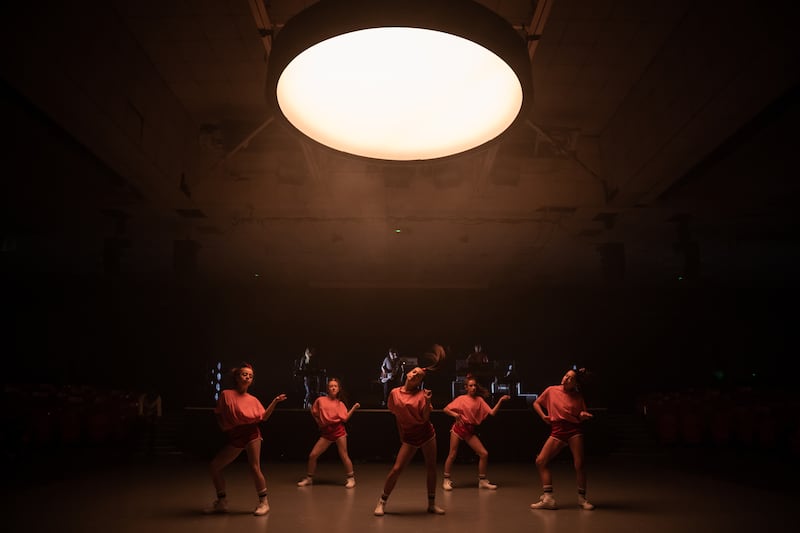It is 2002, and a couple are kissing in the Guggenheim. Art viewing can produce waves of emotion, and sometimes love, but it is unusual for gallerygoers to writhe around the floor in a slow-motion act of passion. Watching the pair in New York feels transgressive, voyeuristic and incredibly intimate. Some people are ignoring requests and taking photographs. Also that year, at the Venice Biennale, a museum guard sings, “This is propaganda, you know you know.” The artist is Tino Sehgal, and something new, strange and remarkable is happening. That kiss, in particular, humanises those long-dead models who embrace eternally in marble and on canvas, at the same time as it makes the couple strangely other – like art itself.
Some 10 years later, at Tate Modern in London, the Turbine Hall is, as usual, filled with mingling visitors, but suddenly 70 of them turn into a flash mob and start playing what looks like a running game. If kissing in a gallery is a no-no, running is definitely beyond the pale. Then an individual separates and turns to talk to a stranger, then another, and another. This time it is Sehgal’s These Associations, for which the British-born, Berlin-based artist will receive a Turner Prize nomination. Although he doesn’t win that year, he goes on to garner the Golden Lion at Venice, and numerous other awards worldwide.
At Tate I watch and wait. I overhear quiet stories being told – sometimes strange, always personal – and I anticipate my turn. But no one comes to talk to me. I begin to feel like I often do at parties: preferring to hang out at the edges while also wanting to want to be in the thick of things. This division of my soul and spirit has never felt more evident, more uncomfortably unavoidable.
“I’m sorry,” Sehgal says via Zoom today. “Mistakes happen. There’s no real explanation.” I try to explain that, with hindsight, I don’t mind. The feeling of suddenly being met with a deep personal insight was worth it, an unlooked-for gift from the artwork.
Visitors to Cork Midsummer Festival will have the chance to receive their own, perhaps unlooked-for emotional gifts when Sehgal brings one of his extraordinary pieces to City Hall this month. He showed at the Irish Museum of Modern Art in 2013, when it was in its temporary home at Earlsfort Terrace, but now he is excited by the idea of the subconscious rituals we may attach to moments such as midsummer, as well as the thought-rich atmosphere of festivals. Sehgal describes his exhibitions, installations, projects, presentations – call them what you will – as “constructed situations”, and it is very hard to put them into words. The artist himself would almost prefer it that way. He does not document his art: there is no official filming, no photography, and he would rather people engage with what they encounter at first hand, instead of reading interviews.
Still, for all that, he is worth the chat: fascinating in conversation, hugely intelligent, thoughtful, abstract, charmingly honest, funny and enigmatic, but never irritatingly so. Instead, talking to him is like being immersed in a gently flowing river of ideas, never being entirely sure where it may take you, and not really wanting to come up for air. There are pauses while he thinks, and his dark eyes focus somewhere in the middle distance, searching for the right word, or maybe he is already imagining something entirely new. In many ways it is a little like being engaged with one of his exhibitions.
“I create live work,” he says. “In the double sense of the word.” He is talking about the way that concerts and theatre are also obviously live but a great deal of their outcomes are already determined by the time they make the stage. Sehgal prefers his work to evolve “in the moment, with certain parameters, and often these parameters and the evolvement is due to you as the visitor”. I am reminded of something the late Roscommon-born artist Brian O’Doherty said about the process of creating and showing his work, including his rope drawings: that the viewer completes them. “Without you there isn’t anything,” he once told me.
Sehgal prefers to cite another Ballaghaderreen-born art megastar, James Coleman, describing him as a “dear friend, and a role model”, admiring the older artist for, among other things, his fidelity to his process and presentation, whether that is by eschewing interviews or insisting on the way his work is to be encountered. For Sehgal, part of that is to avoid creating objects, or what he terms “material residue”. “The deepest thing I learned from James is that you can make something that is not, in the classical sense, visual art.” Sehgal’s desire to leave no art trace, save in the mind and memory, insists, among other things, on the fascinating question: are we interesting, valid even, for the stuff we own, or the gestures we make throughout our lives?
Brought up in Germany to a German mother and a father from what was then British India, Sehgal has an accent that flits between German and English, via points in between. We discuss the way that being not entirely from, or of, somewhere can make you both observer and chameleon. Growing up in a town “of industrial production” also turned him off the idea of producing “things” himself. It was, he says “the place with the most, let’s say, material and goods flowing in and out of it,” adding, “I don’t think anyone makes an artistic work about something they don’t feel strongly about.”
One inspiration came from being a skateboarder as a teenager. Turning stairwells and handrails into sites from which to take flight, “I understood this idea that you can somehow change what something is intended for ... You can transform it through your use.” He also devoured Taschen books on the likes of Marcel Duchamp and Yves Klein. He went on to simultaneously study dance and economics, the latter not to appease anxious parents but because “I thought I need to understand this economically driven society ... My idea was that if I want to change something in this society, I need to understand first how it works.” It was, he says, using one of those long German portmanteau words, a “life art project”.
After those early iterations of his work, I noticed how quickly imitators followed. Booths at the big international art fairs seemed, for a year or two, to sprout living mannequins, moving in stylised ways. And even accounting for the fact that an art fair is not a good or kind place to immerse yourself in art, they seemed clumsy and lacking in meaning or moment. What is it that Sehgal adds to include both, and more?
There is his training in dance and choreography, his experience as a performer, and his studies of economics and the nature of transaction. The work, he says, “didn’t come out of nowhere”. It also comes out of his singular vision, and out of a profound belief that art can be hugely meaningful in its effects. “Where does the power of exhibition art or the museum lie?” he asks, making the point that artists who may not seem vital at this moment can later come to define and influence whole eras. “This will have been the past,” he has said; looking back, we do remember artistic currents more than we do most of the politicians of the time. He is, he says, an optimist, “a somewhat painful transformation”, for which he credits working with younger people, and his own children, who are now 14 and 16.
Families, or rather the bonds of intergenerational care, feature in the Cork Midsummer Festival exhibition. This youiiyou, which is being shown here in conjunction with the National Sculpture Factory, was commissioned by Fundación Botín and exhibited at Centro Botín, in Santander in Spain, in 2023, as a response to El Greco’s 1612 masterpiece The Adoration of the Shepherds, art history being a continuing theme of and inspiration for Sehgal’s work. That painting won’t travel to Ireland, but what you will experience is a group of participants, including babies, and some of the original team from Spain, with a few Cork additions enacting roles of care across the generations.
With choral elements and dance it should create something unforgettable, and almost indefinable, and this is part of the reason Sehgal prefers people to experience his work first-hand rather than through interviews, photographs and film clips. “I chose purposely a medium that has an openness, an openness for others’ interpretation – that’s part of the meaning of production; I always feel this openness gets closed slightly when you start talking to people.” Take my word for it: don’t miss it.
Cork Midsummer Festival runs from Wednesday June 12th to Sunday June 23rd; This Youiiyou, by Tino Sehgal, opens at Millennium Hall on Tuesday, June 18th, and runs until the end of the festival; admission is free, with no booking required
Picks of the festival: Six more shows to see at Cork Midsummer

Theatre for One – This Ireland: Step into a purpose-built booth and experience your own personal drama as 12 short plays are performed by one actor for one audience member at a time. Landmark Productions and Octopus Theatricals, in association with the festival and Cork Opera House, feature work by established playwrights mentoring a line-up of new writers. See what Iseult Deane, Susannah Al Fraihat, Aoibhéann McCann, Joy Nesbitt, Ois O’Donoghue and Aoife Delany Reade have created with Marina Carr, Stacey Gregg, Emmet Kirwan, Louise Lowe, Mark O’Rowe and Enda Walsh. Emmet Place, June 15th-23rd, free and unticketed, expect queues
Night Dances: The acclaimed choreographer Emma Martin’s United Fall has made a celebration of dance culture, from clubs to competitions and ceremonies. Expect ferocious performances and an exhilarating live soundtrack by Daniel Fox of Gilla Band in this sweaty love letter to dance. Marina Market Warehouse, June 13th-15th, €22/€24
Winter Journey – Winterreise Reimagined: Project Arts Centre’s new artistic director and chief executive, Sophie Motley, reinterprets Schubert’s song cycle across eight locations in Shandon, through folk, hip-hop, opera, trad and more. Performers include JFDR, Gavan Ring, Gary Beecher, Lina Andonovska, Outsiders Ent, Neil O’Driscoll, Peter Power, Rachael Lavelle, Ciara O’Leary Fitzpatrick, Johnny McCarthy and Bláithín MacGabhann in this co-production with Islander and the festival. Shandon, June 15th and 16th, €22/€24
Possession: The artist Amanda Coogan teams up with the composer Linda Buckley and their collaborators Alvean Jones, Lianne Quigley and Cork Deaf Community Choir. Based on a script from the deaf artist Teresa Deevy, this opera tells the story of An Táin through the eyes of Queen Medb, combining Irish Sign Language with experimental compositions. Granary Theatre, June 20th-23rd, €15/€25
Tempesta: Inspired by real events, Deirdre Kinahan’s new play features music composed and performed live by Steve Wickham of The Waterboys. Directed by Marc Atkinson Borrull, it follows the story of two Dubliners caught up in the onslaught of war in 1930s Europe, and a surrounding storm of love that takes them from the jazz clubs of Dublin to the battlefields of Catalonia. The Pav, June 16th-23rd, €18/€20
Wiff Waff Is Playing at My Gaff: A fondness for table tennis is one of the untold secrets of the art world, and Davey Moor has been hosting impromptu tournaments and commissioning creative tables from the likes of Elinor O’Donovan, Ella Bertilsson, Liliane Puthod, Prendergast & Moor, Dáire McEvoy, Tanad Aaron and David Lunney. Try your hand on their takes on the traditional wiff-waff table (wiff waff being an old name for the game) and look out for pop-up tournaments throughout the run. Crawford Art Gallery, June 14th-July 7th, free















